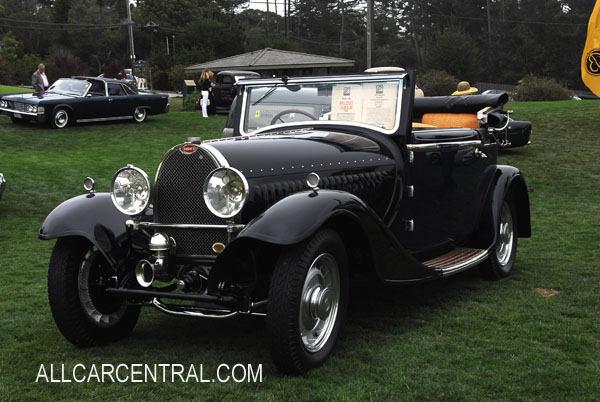Bugatti Type 49
Bugatti Type 30 is the name of a car model of the car manufacturer Bugatti.
The Type 30 was the first produced by Bugatti in production car with an eight-cylinder engine, engine capacity 1991 cc. He was also the predecessor of the famous car of this brand, the Bugatti Type 35 which had its race debut in 1924 at the Grand Prix of France in Lyon. There Bugatti had traveled with seven vehicles and 45 tons of equipment. The further development of the Type 35 in different variants with and without compressor won numerous races until 1930.
History of development
The Type 30 was not only the first Bugatti with eight cylinders, but also had an engine, the predecessor of a number of successful 1991 cc racing aggregates of the 1920s and was initiated the development of type 35. In addition, it was the first Bugatti with four braked wheels. These brakes were operated by means of Bowden cables, although was initially experimented with a hydraulic system for the front wheels.
The slightly extended chassis (wheelbase 2850 mm) and the suspension of the Type 30 were from the Type 23 " Brescia ". However, the engine has the first eight-cylinder engine with three valves per cylinder ( two intake valves, an exhaust valve ), which are controlled by means of rocker arm from the camshaft. The Type 30 came as a sporty touring cars on the market. However, Bugatti also developed race car based on the Type 30, so it was often difficult to recognize in these years, which models should be used for which purpose. A total of 600 Type 30 were produced in just four years 1922-1926. His successor was the Type 38, which was offered with an extended wheelbase of 3120 mm, with an improved engine with the same cubic capacity, as a chassis or as a sporty touring car.
Technical data of type 30
- Engine: eight cylinder in-line, OHC ( overhead camshaft )
- Bore / Stroke: 60 mm × 88 mm
- Displacement: 1991 cm ³
- Power: 70 hp
- Transmission: Four -speed manual, rear-wheel drive
- Chassis: ladder frame
- Suspension: rigid axle, semi-elliptic springs front; inverted Viertelelliptikfedern back
- Brakes: drum brakes
- Body: Aluminum
- Maximum speed: 120 km / h
The successor to the Type 30 Bugatti Type 35 and Type 39
Bugatti's famous racing series developed from the Type 30, but with a shorter wheelbase (2400 mm) and smaller, narrow and sparsely equipped two-seater bodywork. The 2- liter engine of the Type 30 had a three-fold ball bearing crankshaft and developed 70 hp at 4300/min. This engine was also used in the Type 35 A, a "civilian" version of the race car. The type can be seen, among other things, that he did not have the aluminum wheels of the car, but then in use spoked wheels.
In contrast to the Type 30 was developed for racing engine of the Type 35, a five -bearing crankshaft ( ball bearings at the ends and in the middle, in between each one roller bearing) and also roller-bearing connecting rods. This necessitated a composite crankshaft, which was reflected in the price. So cost of the Type 35 racing car Fr. 100,000, while the Type 35 A for Fr. Was to have 65,000. The 2- liter naturally aspirated engine developed 90 hp at 6000 rpm. At the Grand Prix of Lyon in August 1924 put five of these new Bugatti racing cars, but had tire problems and reached only the seventh and eighth place. Also the 1926 model used in the Targa Florio 35 T had an enlarged to 2262 cc aspirated engine (T stands for Targa Florio ).
The later types 35 B and 35 C had a side-mounted to the engine Roots supercharger, they are recognizable by the hole in the right hood, lies in the extension of the compressor pressure relief valve. The Type B made with the 2262 - cc engine 130 hp and the Type C with 1991 cm ³ 120 PS. The engine of the type 35 B was also offered in a sports car, the Type 43 with a wheelbase of 2970 mm.
The type 39 corresponded to 35 C with a 1493 cc engine and 110 hp; of 39 A was a more powerful version with a different bore / stroke ratio. Interesting, but without success was the Type 36, a single-seater with a sliding short scenes sprung front axle and a rear axle mounted rigidly to the chassis. Also single with a 1100 cc supercharged engines that have been used by private drivers are known.
It should be noted that Bugatti cylinder blocks produced with a bore of 60, 54, 52 and 51.3 mm. On the other hand, he put forth crankshaft with a stroke of 100, 88, 81 and 66 mm. He was thus able to offer eight-cylinder engines with a displacement of 1100, 1500, 2000 and 2300 cc.
Bugatti Type 37
The Bugatti Type 37 was created from the Type 35 in the Grand Prix chassis of the Type 35, the 4-cylinder engine was ( 1496 cc ) built the Type 40 touring car. The Type 37 A also had the engine of the Type 40, but the performance was measured using a Roots compressor up to 66 kW increased (90 hp). Because of the lighter engine, he weighed only 720 kg, as the Type 35A, he had spoked wheels.
Bugatti Type 40 to Type 44 and Type 49
Bugatti Type 51
This used by Bugatti in 1931 Grand Prix race car based on the Type 35 chassis with a newly developed eight-cylinder engine with two overhead camshafts. The 2262 cc engine produced 170 horsepower, the engine of the Type 51 A with 1493 cc delivered 130 hp.









